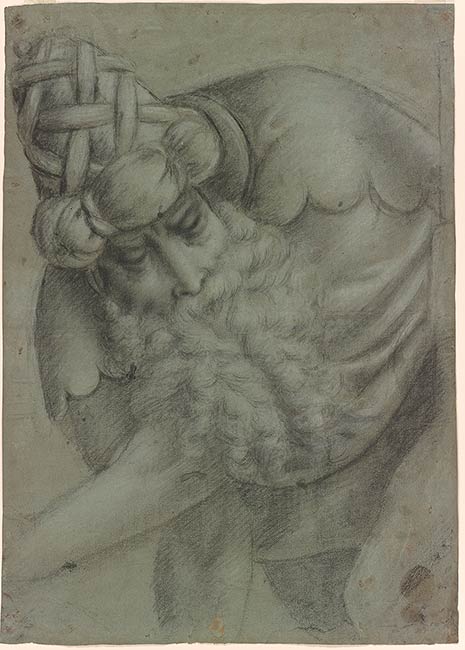
Along with the delicate compositional studies in white opaque watercolor on colored paper (see 1973.36), one of the distinctive modes of drawing in the circle of artists active in Lombardy and Piedmont during the sixteenth century was the creation of highly detailed cartoons in black and white chalk at the scale of paintings. Some of these were used to transfer the design to a fresco, panel, or canvas, but others represent a different type of drawing, the so- called ben finito cartone, a sort of substitute cartoon that was not damaged by the pricking, pouncing, or incising used to transfer the design but which instead was a second version that could be saved or presented to a patron.1 Some of these are full cartoons made up of multiple sheets of paper glued together. Others, such as the present example, fit on a single sheet of folio-sized paper and are perhaps elegant fictions pretending to be the fragments of cartoons but actually just the drawing of a figure or two, made for collectors who prized drawings that were apparently part of the working process.2 The anatomy of the Bearded Man Wearing a Turban is not entirely convincing— the man seems oddly flattened—which further suggests that the figure was copied by Lanino from another cartoon or a painting.
Leonardo was responsible for creating a taste for the ben finito cartone, but his Piemontese followers Gaudenzio Ferrari, Bernardino Lanino, and their associates became the most active proponents of the tradition, and scores of similar drawings are still held in the Accademia Albertina in Turin today.3 The sfumato technique of figures drawn in a haze of black chalk is likewise an echo of Leonardo’s drawing style, and that, as well as the relatively bold and forcefully twisting figure suggests that the drawing must have been made after Lanino had begun spending time in Milan around the middle of the sixteenth century.
Although there are many figures with similarly elaborate turbans and broad, curling beards in Lanino’s work—as indeed in that of his master, Gaudenzio Ferrari—there is no corresponding figure in any surviving painting. It seems odd, however, that a drawing of this type would have been made without another project in mind, so the figure probably relates to a lost work. The turbaned figure could have represented one of the Magi, or Joseph of Arimathea in a Deposition or Lamentation, or any non-Christian. Given his dramatic gesture, he may have been one of the pagan philosophers who debated with and condemned St. Catherine in a lost fresco from the Oratory of St. Catherine in Vercelli. A drawing in the Ashmolean Museum (Ashmolean Museum, Oxford, inv. WA1952.10) shows the Disputation of St. Catherine, but the subject of the corresponding painting was later changed and Lanino instead painted St. Catherine Condemned by the Emperor Maxentius. It is tempting to think that the dramatic figure could have been for the latter work, the spirit of which would likely echo that of the dramatic frescoes of the same subject that Lanino had painted at San Nazaro Maggiore in Milan a few years earlier.4
—JJM
Footnotes:
- Bambach 1999, chapters 7 and 8.
- For another example, see Lanino’s Two Apostles in the Yale University Art Gallery, New Haven, inv. 1961.9.53 (New Haven and else- where 2006–8, no. 13).
- See Turin 1982.
- For the St. Catherine series, see Coleman 1996.
Watermark: none.
Formerly attributed to Gaudenzio Ferrari, Valduggia near Vercelli 1475-80-1546 Milan.
Inscribed on piece of paper pasted onto verso, at upper left, in pen and brown ink, "Lanino.o"; on another piece of paper, at upper right, in pen and brown ink, "26".
Ferrari, Gaudenzio, approximately 1470-1546, Formerly attributed to.
Savoy, Dukes of, former owner.
Savoia-Genova, Tommaso di, 1854-1931, former owner.
Abrate, Antonio, 1834-1925, former owner.
Bertarelli, Ernesto, 1873- former owner.
Matthiesen, Francis, 1897-1963, former owner.
Scholz, János, former owner.
Rhoda Eitel-Porter and and John Marciari, Italian Renaissance Drawings at the Morgan Library & Museum, New York, 2019, no. 51.
Selected references: Rodolfo 1927, 11; Oakland and elsewhere 1956, no. 31; Bloomington and elsewhere 1958, no. 24; Detroit 1960, no. 29; Staten Island 1961, no. 25; Washington and New York 1973-74, no. 72; Romano et al. 1986, 287; Coleman 1988, 660-61; Tordella 1996, 25n65.
Mostra di Gaudenzio Ferrari, Museo Borgogna, Vercelli, 1956, no. 31.
Oberhuber, Konrad, and Dean Walker. Sixteenth Century Italian Drawings From the Collection of János Scholz. Washington, D.C. : National Gallery of Art ; New York : Pierpont Morgan Library, 1973, no. 72, repr. (includes additional bibliography and exhibitions)
Ryskamp, Charles, ed. Twentieth Report to the Fellows of the Pierpont Morgan Library, 1981-1983. New York : Pierpont Morgan Library, 1984, p. 256.
